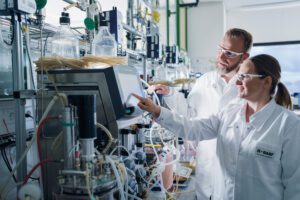Numerous factors influence the efficiency of the enzymes used to produce chemicals. Finding the optimal reaction conditions therefore requires significant time and resources. Researchers from BASF SE (Ludwigshafen, Germany), the Austrian Research Centre of Industrial Biotechnology (acib) and the University of Graz in Austria have co-developed a fundamentally new computer-assisted model that can improve enzyme performance and enable new biocatalytic production processes to be scaled up faster from the lab to industrial manufacturing.
Enzymes are proteins that perform many functions in the human body and all other organisms. They are biological catalysts that speed up chemical reactions. Enzymes are involved in almost all metabolic processes in the body, such as the digestion of food or the formation of cells and tissue. The chemical industry also uses enzymes as biocatalysts in production processes. BASF uses them to make products such as vitamins, flavorings or ingredients for cosmetics and detergents.

BASF’s fermentation laboratory in Ludwigshafen (Source: BASF)
But enzymes are very sensitive and stop working properly if, for example, the temperature is too high. “They are then no longer correctly folded and lose their three-dimensional structure, which means no further catalytic reactions can take place in their active center,” explains Dr. Stefan Seemayer, global head of computational protein engineering at BASF. However, enzymes also cannot function optimally when temperatures are too low, producing lower volumes of the desired product.
The activity of the biocatalysts can also be influenced by substances contained in the reaction medium, such as solvents. “We need solvents so that the enzymes can quickly produce large amounts of the desired end product from the starting materials, for example, fats,” says Seemayer. Without solvents, the enzymes are unable to fully access the substances and transform them into other materials. But if the solvent concentration or the temperature are too high, the enzymes lose their structure and stop being active. On the other hand, if the concentration or the temperature are too low, this can reduce product output.
Finding an optimal combination of temperature and solvent concentration
“In order to get the largest possible amounts of the desired product, we need to find the optimal point for the enzyme, where both the reaction temperature and the solvent concentration result in the highest possible activity,” Seemayer stresses.
In the past, determining this optimal combination of temperature and solvent concentration was a complex process involving many laboratory experiments. Researchers from BASF, acib and the University of Graz have now developed a regression model as an extension of conventional biochemical models. A regression model is a statistical method used to analyze and predict biochemical reactions based on collected scientific data. This model makes it significantly easier to determine the optimal combination. Only a few preliminary lab tests, such as determining the unfolding curve of the enzyme, are necessary. The obtained data are entered into the computer model, which then computes the optimal combination of reaction temperature and solvent concentration for the best-possible enzyme performance.
“This sounds simple, but it considerably improves the efficiency of biocatalytic processes and gives us a new understanding of enzymatic catalysis,” Seemayer says. Owing to the major scientific significance, the researchers were able to publish their findings in one of the most renowned scientific journals, Nature Communications.
With this new method, different enzymes can be compared more easily with each other, and their performance can be optimized. “This considerably reduces our efforts to find the most suitable conditions for each new production process. We can therefore conclude our research and development work in the laboratory more quickly and thus begin to scale up production faster. This significantly lowers costs and resource consumption, improving the sustainability of biocatalysis,” Seemayer stresses.
BASF also recently entered a research partnership related to the development of fermentation pathways for bio-based fumaric acid.